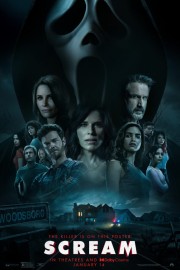Scream
It’s not really a surprise that the two films in the “Scream” franchise that are the weakest were not written by Kevin Williamson. While he is an executive producer here, his deft ability to write characters and situations with a wink, a smile, and a sense of understanding for the emotions behind the characters is sorely missing from both “Scream 3”- although that one is redeemed by Wes Craven’s astute direction, and some terrific supporting performances- and 2022’s “Scream.” While the fifth film in the self-aware slasher franchise is entertaining enough, it is missing the innate appreciation for genre that Williamson and Craven brought to the table, while it also asks us to accept some wild plot devices.
By continuing for as long as it has, the “Scream” series has- ironically- become one of those never-ending slasher franchises it was parodying with the first three films. Part of the reason it’s worked has been the foundation Craven and Williamson built it on was so strong. Another reason is because, in a twist from most of the franchises in the genre, “Scream” has been built more around its heroine- Sidney Prescott (Neve Campbell)- than one defined killer. Yes, Ghostface is a part of the picture every time out, but the identities of the killers have basically revolved around who is looking to go after Sidney, and what their motivations speak about the obsession with horror movies. It’s an interesting concept, but the longer it goes on, the more one has to strain credibility to make it work.
One of the main characters of a “Scream” film being a young woman who is haunted by the idea that their father was one of the Ghostface killers is an interesting idea. But by having Samantha (Melissa Barrera) be the daughter of Billy Loomis (Skeet Ulrich), one of the killers from the first film 25 years ago, it raises questions the screenplay by James Vanderbilt and Guy Busick is not prepared to answer. If this had been a concept from the terrific fourth film in 2011, where there was 15 years removed from the original instead, I think it would have worked a lot better, not just because the time frame between narratives wouldn’t have been quite as stretched out, but because that film dealt more with Sidney, so maybe she could have had more of an arc in terms of the realization of what that revelation is, and how she processes it. Here, Sidney (whom is essentially a cameo here) basically takes it as fact that Billy fathered a daughter, and that doesn’t seem to impact her, even though it would have to mean that he probably cheated on her while they were in high school. Plus, Woodsboro is a small town- how would this not have been common knowledge for basically everyone? As an isolated arc, I really like Sam as a character, the reasons she felt she needed to leave Woodsboro and her younger sister, Tara (Jenny Ortega), and how she feels drawn back in after Tara is attacked in this film’s great opening sequence, but the more you think about the implications of this arc, the less sense it makes in the world of “Scream,” 25 years removed from Ghostface’s first appearance.
I love that the “Stab” franchise- which was inspired by the events of the first “Scream,” as told in Gale Weathers’s (Courtney Cox) trashy true crime book about the Woodsboro murders- lapped the “Scream” franchise in how many films it contains, and it’s become a living thing in the world of the films. I also like that there’s a weird possessiveness the younger generation of Woodsboro has with the film- for them, it’s not an exploitation of tragedy, but that the original was inspired by events in their small town doesn’t phase them; it’s made the town famous. On the one hand, that speaks to how desensitized people can get to real-world violence as a result of being saturated to violence as entertainment- which is part and parcel for this franchise- but I also was reminded about how, if you go to Savannah, Georgia, the book Midnight in the Garden of Good and Evil (and, to a certain extent, Clint Eastwood’s 1997 adaptation of it) has become something the city has embraced as part of its culture- just about every shop you go into, or tour around the city, either has that book available, or mentions it. I like how, with “Scream 4” and now this one, that same sense exists with the “Stab” movies, and the films make a point of showing what that says about the culture of those younger than Sidney, Gale and Dewey (David Arquette).
Overall, I think more works in the film Matt Bettinelli-Olpin and Tyler Gillett (“Ready or Not”) have directed than not. They have a strong sense of keeping the film moving and staging the kills here, and they do well in playing into the franchise’s sense of what it’s doing in terms of the meta-textual aspects of being a straight slasher series about the conventions of slasher films. The rationale the killers have makes sense, even if some of their behavior does not, and the ways the legacy trio of Sidney, Gale and Dewey are used works. I just think the main miscalculation I discussed earlier- while interesting- stretches past reality for the film, and the third act has way too much leg work to do to get to where it leaves the film at by the end. That being said, the central characters are engaging, and I’m looking forward to seeing what they have to face from Ghostface coming up next. Consider the hook properly baited.










